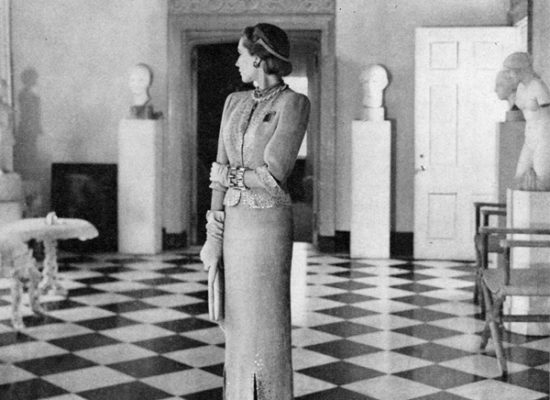Helena Rubinstein holding one of her masks from the Ivory Coast, 1934.
Photograph by George Maillard Kesslere.
Courtesy of the Helena Rubinstein Foundation Archives, Fashion Institute of Technology, SUNY, Gladys Marcus Library, Special Collections
Graham Sutherland Helena Rubinstein in a Red Brocade Balenciaga Gown, (1957).
Courtesy of Daniel Katz Gallery, London
© Estate of Graham Sutherland
Helena Rubinstein's flagship beauty salon at 715 Fifth Avenue, New York, 1941.
Vintage Helena Rubinstein compact.
Photograph by Bradford Robotham
Rubinstein wearing a 1923 Paul Poiret dress, photographed by Nickolas Muray (c. 1924).
Courtesy of George Eastman House, International Museum of Photography and Film.
© Nickolas Muray Photo Archives
Pablo Picasso
Portrait of Helena Rubinstein XIX 27-11-1955, (1955).
Courtesy of Himeji City Museum of Art, Japan. © 2014 Estate of Pablo Picasso / Artist Rights Society (ARS), New York.
Punu face mask (mukudj)
Gabon, (date unknown).
Courtesy of The Kreeger Museum, Washington, DC
Andy Warhol Madame Rubinstein in Kyoto, Japan, 1957
Ink with white highlights on paper, 16 3/4 x 22 in. (42.5 x 55.9 cm)
Williams College Museum of Art, Gift of Richard F. Holmes, Class of 1946
© 2014 The Andy Warhol Foundation for the Visual Arts, Inc. / Artists Rights Society (ARS), New York
Fernand Léger
Interior, study for The Three Women, (1921).
Courtesy of the Museum of Fine Arts, Houston. Gift of Madame Helena Rubinstein
© 2014 Artists Rights Society (ARS), New York / ADAGP, Paris.
A 1949 French advertisement for complexion powder and rouge, drawn by Bernard Villemot.
© 2014 Artists Rights Society (ARS), New York / ADAGP, Paris
Helena Rubinstein in front of a montage of some of the many portraits she commissioned throughout her life.
clockwise from top right: Roberto Montenegro, 1941. Cândido Portinari, 1939; Marie Laurencin, 1934; Margherita Russo, 1953; Pavel Tchelitchew, 1934; Christian Bérard, 1938; and Graham Sutherland, 1957.
Courtesy of the
Helena Rubinstein Foundation Archives, Fashion Institute of Technology, SUNY, Gladys Marcus Library, Special Collections
A fashion shoot for Bergdorf Goodman staged in the foyer of Helena Rubinstein's New York home at 625 Park Avenue, (1944).
Photograph by John Rawlings.
Vogue / Condé Nast Archive
Elie Nadelman
Head of a Woman, (c. 1907–8).
Hirshhorn Museum and Sculpture Garden, Smithsonian Institution, Washington, DC, Gift of Joseph H. Hirshhorn, 1966
© Estate of Elie Nadelman
Helena Rubinstein reads by the fluorescent lighting that suffuses the head and foot of her Lucite bed, designed by Ladislas Medgyes in the late 1930s.
Photograph by Herbert Gehr/Time Life/Getty Images
This season, New York has the distinction of hosting extraordinary art collections assembled by two cosmetics magnates. Currently on view at the Metropolitan Museum of Art is the billion-dollar trove of Cubist masterpieces acquired over the past forty years by Estée Lauder chairman emeritus Leonard A. Lauder, a promised gift to the museum.
Opening today at the Jewish Museum, “Helena Rubinstein: Beauty is Power” is a visually stunning and thought-provoking exhibition centered on the life and treasured art works of a proto-feminist pioneer. Born in Poland, Helena Rubinstein (1872–1965) immigrated to Australia, where she set up a cosmetics and beauty salon business in 1904 that would soon become a global enterprise. Brandishing the slogan “Beauty is Power,” she succeeded as few others had in the male-dominated business world of the early 20th century, especially as a Jewish woman from Central Europe establishing herself in the world’s fashion capitals. She also happened to have very good taste in art, and her adventurous spirit gravitated to the avant-garde.
Works from her collection included in the show, by Picasso, Matisse, Léger, Miró, Max Ernst, Frida Kahlo, Leonor Fini, and Andy Warhol, are a testament to her understanding of the advanced art of her day. Rubinstein was a longtime friend of Dalí, who she commissioned to decorate her various apartments in Paris, London, and New York. With Picasso, she shared a love of African art, and became something of an expert in the field. One memorable display in the show features her extensive collection of marble sculptures by Elie Nadelman juxtaposed with some of her prized African wood carvings.
Far ahead of her time, Rubinstein, who employees and friends alike referred to as “Madame,” explored the concept of branding her own image to help promote her cosmetics business. She was not a beautiful woman in conventional terms, but her sense of fashion and glamour come across in the many portraits of herself she commissioned. Outstanding here are paintings by Marie Laurencin, Christian Bérard, and especially a large, resplendent 1957 canvas by Graham Sutherland, one of the best examples of the British artist’s portraiture.
Also included in the show, organized by museum curator Mason Klein, is a wide array of documentary material and photographs that help illuminate the life and times of this unique and prescient character.
“Helena Rubinstein: Beauty is Power” is on view at the Jewish Museum through March 22, the show travels to the Boca Raton Museum of Art, FL. (April 21-July 12, 2015).
